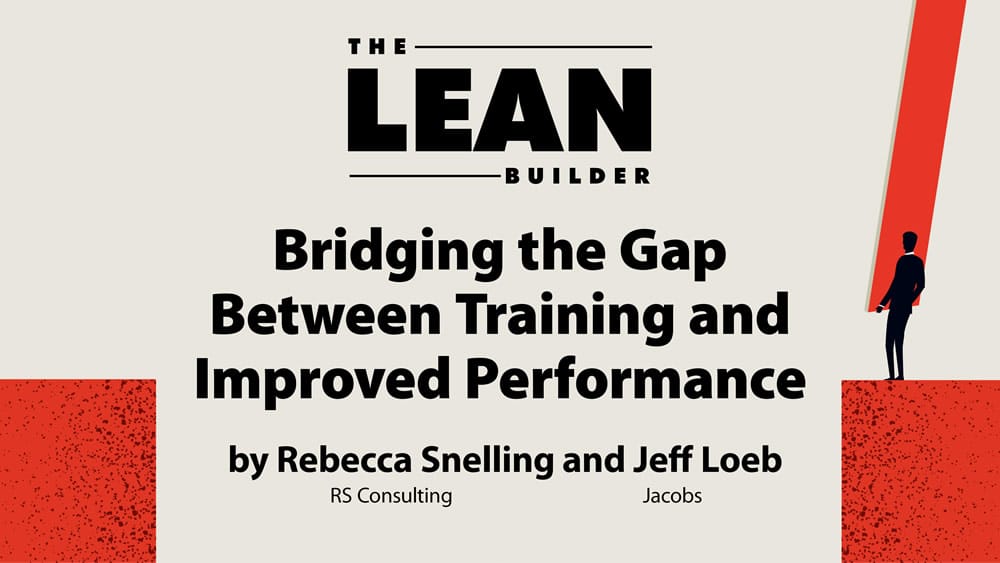Bridging the Gap Between Training and Improved Performance by co-authors Rebecca Snelling and Jeff Loeb. Don’t let your training go to waste – apply what you learn and see real results.
Bridging the Gap Between Training and Improved Performance
Have you ever taken training and thought to yourself “This is great! I can’t wait to use what I’m learning!”? Then fast forward a few days, weeks, or months and you haven’t changed your daily behavior based on the training you took.
If you’ve experienced this, you’re not alone. According to studies (10 Stats About Learning):
- After one hour, people retain less than half of the information presented.
- After one day, people forget more than 70 percent of what was taught in training.
- After six days, people forget 75 percent of the information in their training.
In the design and construction industry, we tend to be clumsy in how we talk about learning. We often assume that “training” equals “learning.” That simply isn’t true, especially when we look at the social skills and behaviors – those sociotechnical practices central to a Lean project or organization.
As a Lean mindset is focused on continuous improvement and optimizing the whole, we’d like to share ideas on how to improve learning outcomes when training your project teams. These concepts work for all types of training needs and goals.
Training Misconceptions and Pitfalls
Training courses feature many levels of participant involvement. Often, we see training offered that is primarily showing, telling, directing, and correcting people (or worse – just presenting a PowerPoint!). When training is divorced from practice, “building awareness” is about the limit of what is accomplished with a training effort, even though the perception remains that people have “learned.”
More helpful training programs include classroom practice and quizzes. These methods help students remember more of what they are being taught. Other training types will assign accountability partners or practice assignments to complete in the real work environment outside the classroom or training module. These are all workarounds for the lack of practical application with coaching. It is left to the student to prioritize practicing in the real world and to solicit feedback on their skill.
Even more important, the sponsoring organization must be organized so that the student can put the new skills to work and access effective coaching to improve. Essentially, organizations should provide an environment or practice in which these skills are not only accepted but also expected for the participant to be successful within the organization. Without it, training often falls short of developing the person to become skilled or well-versed, and it does not elevate the overall performance of an organization or team.
Classroom training can create the illusion that we’ve developed new skills in people. Then when the skill does not take hold, people may assume that the skill or the training is worthless. This creates resignation and deepens skepticism, which further impedes learning the skill and putting it into practice.
On the other hand, if practicing the new skill in the organization is not met with support, it can create a different kind of resignation, this time about the organization. We’ve heard people say, “Why are they having us learn all of this when my leaders don’t act this way?”
Matching the Training Mode with the Learning Need
Here is a way we propose to think about “training” and “learning” differently.
One mode of developing capability is not necessarily better than another. Rather, different modes are appropriate for different situations. This becomes an issue when the skills are novel, complex, or social and require more than procedural compliance. Too often we mismatch the mode with the need.
| Mode | Means | Outcomes |
| Directive
|
Telling or commanding | Task compliance |
| Documented instruction | Reading and following procedures; can include video | Predictably correct and consistent results |
| Interactive instruction | Explaining and showing with Q&A | Ability to follow a procedure or process |
| Teaching | Instruction with practice in some skills away from performance; includes hands-on practice, feedback, and dialogue | Readiness to practice with coaching in action |
| Coaching for development | In, before, and after-action reflective dialogue; coached by someone with domain expertise and competence | Capability in a domain of practice
1. Long-term excellent performance. 2. Self-correcting and adaptive. 3. Self-generating |
| Mentoring | Longer-term relationship with a trusted advisor; includes recurring, open dialogue | Effective career guidance |
| Facilitated collaborative work practices | Facilitated collaborative sociotechnical practice; learning by doing with others; includes coaching, punctuated with instruction or teaching. | Individual and community capacity for effective action and breakthrough results |
What do we propose you may try after reading this blog?
First, take active ownership of your personal growth and development. Put your new skills into practice and ask others for coaching and feedback. Reflect on your practice and identify areas that went well and areas you can improve.
If you are a Lean leader, build reflection and coaching into your team’s training and work practices.
You might also share this post with people who have a wider span of control to influence their organization’s learning and development practices.
Related Information
About the Authors
Jeff Loeb
Lean Practice Director
Jacobs, Advanced Facilities – Electronics










